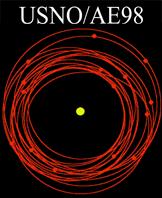USNO/AE98
(Discontinued)
U.S. Naval Observatory Ephemerides of the Largest Asteroids

USNO/AE98 contains ephemerides for fifteen of the largest asteroids that
The Astronomical Almanac
used from 2000 through 2015. These ephemerides are based on the Jet Propulsion
Laboratory (JPL)
planetary
ephemeris DE405
and, thus, aligned to the
International Celestial Reference System
(ICRS). The data cover the period from 1799 November 16 (JD 2378450.5)
through 2100 February 1 (JD 2488100.5). The internal uncertainty in the
mean longitude at epoch, 1997 December 18, ranges from 0.05 arcseconds for
7 Iris through 0.22 arcseconds for 65 Cybele, and the uncertainty in
the mean motion varies from 0.02 arcseconds per century for 4 Vesta to 0.14
arcseconds per century for 511 Davida.
The Astronomical Almanac has published ephemerides for 1 Ceres, 2 Pallas,
3 Juno, and 4 Vesta since its 1953 edition. Historically, these four
asteroids have been observed more than any of the others. Ceres, Pallas, and Vesta
deserve such attention because as they are the three most massive asteroids, the
source of significant perturbations of the planets, the largest in linear size, and
among the brightest main belt asteroids. Studying asteroids may provide clues to the
origin and primordial composition of the solar system, data for modeling the chaotic
dynamics of small solar system bodies, and assessments of potential collisions.
Therefore, USNO/AE98 includes more than the traditional four asteroids.
The following criteria were used to select main belt asteroids for USNO/AE98:
- Diameter greater than 300 km, presumably among the most massive asteroids
- Excellent observing history and discovered before 1850
- Largest in their taxonomic class
The massive asteroids included may be studied for their perturbing effects on the
planets while those with detailed observing histories may be used to evaluate the
accuracy limits of asteroid ephemerides. The fifteen asteroids that met at least one
of these criteria are
- 1 Ceres
- 2 Pallas
- 3 Juno
- 4 Vesta
- 6 Hebe
- 7 Iris
- 8 Flora
- 9 Metis
- 10 Hygiea
- 15 Eunomia
- 16 Psyche
- 52 Europa
- 65 Cybele
- 511 Davida
- 704 Interamnia
The refereed paper by
Hilton (1999, Astron. J. 117, 1077)
describes the USNO/AE98 asteroid ephemerides in detail.
The associated USNO/AA Tech Note
1998-12 includes residual plots for all fifteen asteroids and a comparison between
these ephemerides and those used in The Astronomical Almanac through 1999.
For interest in USNO/AE98 please contact usno-ops-center@us.navy.mil.

